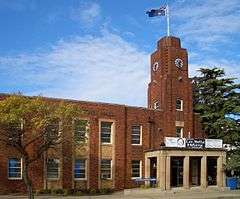History of the City of Rockdale
The City of Rockdale was originally known as the Municipality of West Botany. The Municipality was declared on the 13 January 1871. It covered 4 square miles (10 km2). There were two wards, Arncliffe (with 221 inhabitants of whom 86 could vote) and West Botany (with 543 residents of whom 125 were eligible to vote). On 11 February elections were held to nominate three aldermen from each ward. The first Council meeting was held on 13 February 1871.
The district had three main public roads: Rocky Point Road (from the Cooks River dam wall to Rocky Point at what is now Sans Souci), West Botany Street (which veered to the east off Rocky Point Road about one kilometre south of the dam) and Forest Road (which left Rocky Point Road south of West Botany Street in a south-westerly direction). There were 10 other public streets open to traffic in the Municipality and numerous private roads and tracks by which people accessed their properties.
The Council moved into the first permanent Council Chambers on 7 January 1873. Twice the wooden floor of the building was destroyed by termites. A concrete floor was then installed.
Muddy Creek impeded access to Lady Robinson Beach at the northern end. From about 1875 Sandringham Road provided access to the beach from Rocky Point Road. Over time, Bay Street, President Avenue, Bestic Street, Ramsgate Road and Barton Street were built or extended to also give access to the beach. Most of these roads needed bridges to cross creeks or swamps. Flooding was a periodic problem for the bridges were often swept away and needed to be replaced.
A change of name
In 1882 the Council meeting proposed a change of name for the municipality from West Botany to Dearborough. To alter the name required an act of Parliament and so the suggestion was allowed to lapse. In 1885 a change of name was again discussed. The Colonial Secretary was asked to introduce a bill to change the name to Scarborough. In November, 1887 the Council again approached Parliament for a change of name for the Municipality. This time a name change was accepted.
The new name, Municipality of Rockdale, was legalised on 17 May 1887. The Municipality of Rockdale became the City of Rockdale in 1995.
A growing and developing district
By 1883 (POD 1884) the area controlled by the Council covered 9 square miles (23 square kilometres). The boundaries were very similar to those of the present-day City of Rockdale, excluding the airport and allowing for the changed position of the mouth of the river. There were now 17 public streets. The railway was being constructed. Speculators bought large expanses of land, often at an under-valued price soon regretted by the previous owner. Usually the land was sub-divided for housing soon afterwards. The new owners made a considerable profit.
After the railway became operational the district expanded quickly, especially near Bay Street, Rockdale. Within a couple of years the region altered from rural to suburban and the main centre of activity moved from Arncliffe to Rockdale with its proximity to Lady Robinson Beach. The change in occupations of the residents from 1884 onwards is also apparent when the occupations of the residents listed in succeeding Post Office Directories of the period are compared.
Council Chambers

By the mid-1880s the council had out-grown the original building. In August 1886 a third Ward, the Scarborough Ward, was established, covering all that part of the municipality south of Bay Street. In 1887 a Town Hall incorporating Council Chambers was built at Rockdale at the site of the present Town Hall to the design of William Kenwood. The 1887 building was replaced by the existing current Rockdale Town Hall in 1940. It was designed by the then Rockdale architect Douglas Gardiner.[1] The hall has been the site of many important public occasions including celebrations for the Coronation of Queen Elizabeth II on June 2, 1953. It continues to serve today as a hall and library.[2]
Changing the boundaries
Periodically the boundaries of the Municipality have changed. Initially the boundaries covered mainly the urbanised areas only. As urbanisation continued more villages were incorporated into the Municipality.
The area of the municipality was reduced when the mouth of Cooks River was moved about one kilometre south of its original position in the mid-1940s, to allow for the extension of Sydney Airport. The full area was restored in 1948, when Rockdale and Bexley Councils were amalgamated as Rockdale Municipal Council. When the airport was later included in the boundaries of the City its area became greater than that of the original municipality. As the city's population increased, more suburbs were created within its boundaries.
Topology
The municipality comprises three distinct regions. On the low-lying, mostly flat terrain bordering the beach are the bayside suburbs. During the initial development of the region they were limited to the west by creeks and swamps. The area was covered by dense scrub. Forest covered the ridges and hills of the hinterland over which the railway now passes. Here the suburbs of Arncliffe, Rockdale and, later, Banksia and Bexley are found.
Lord Mayors
William Yates (1871), James Beehag (1872-1874), Elias Godfrey (1874), James Beehag (1875-1876), John Bowmer (1877-1880), William George Judd (1880-1885), A G Carruthers (18?-1892), William Taylor (1892-?)
References
- ↑ "BUILDING AND CONSTRUCTION.". The Sydney Morning Herald (NSW : 1842 - 1954). NSW: National Library of Australia. 16 January 1940. p. 7. Retrieved 31 July 2014.
- ↑ Flickr Retrieved 31 July 2014.
- A Century of Progress Rockdale 1871-1971, compiled by Rockdale Municipal Council, produced by Paul Horne and printed by Posters Pty, Ltd, Lane Cove
- Geeves, Phillip and Jervis, J (1986) Rockdale: its beginning and development Revised Edition
- Sands Post Office Directories (1880-1932/33)(POD)
- Street Directories (various publishers and editions)